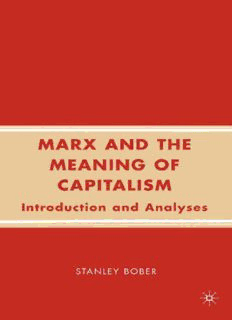
Marx and the Meaning of Capitalism: Introduction and Analyses PDF
Preview Marx and the Meaning of Capitalism: Introduction and Analyses
Marx and the Meaning of Capitalism Marx and the Meaning of Capitalism Introduction and Analyses Stanley Bober MARXANDTHEMEANINGOFCAPITALISM Copyright © Stanley Bober,2008. Softcover reprint of the hardcover 1st edition 2008 978-0-230-60679-1 All rights reserved. First published in 2008 by PALGRAVE MACMILLAN® in the US—a division of St.Martin’s Press LLC, 175 Fifth Avenue,New York,NY 10010. Where this book is distributed in the UK,Europe and the rest of the world, this is by Palgrave Macmillan,a division of Macmillan Publishers Limited, registered in England,company number 785998,of Houndmills, Basingstoke,Hampshire RG21 6XS. Palgrave Macmillan is the global academic imprint of the above companies and has companies and representatives throughout the world. Palgrave® and Macmillan® are registered trademarks in the United States, the United Kingdom,Europe and other countries. ISBN 978-1-349-60342-8 ISBN 978-0-230-61371-3 (eBook) DOI 10.1057/9780230613713 Library of Congress Cataloging-in-Publication Data Bober,Stanley. Marx and the meaning of capitalism :introduction and analyses / by Stanley Bober. p.cm. 1.Marxian economics.2.Capitalism.I.Title. HB97.5.B538 2008 335.4(cid:7)12––dc22 2007050114 A catalogue record for this book is available from the British Library. Design by Newgen Imaging Systems (P) Ltd.,Chennai,India. First edition:July 2008 10 9 8 7 6 5 4 3 2 1 Transferred to Digital Printing 2009 To Sharon and Mitchell,my constant sources ofinspiration. Contents Preface ix Acknowledgment xi 1 The Philosophy 1 2 The Basic Design 15 3 Value and Transformation 33 4 Critical Observations 57 5 Rebuttal and Defense 83 6 Crises in Capitalism 139 7 End Thoughts and Marxian Relevancy 177 Notes 187 Bibliography 197 Index 201 Preface This book undertakes a study of the economics of Karl Marx because his analysis imparts to us an essential truth,or ideological imprint, about capitalism as a social and productive structure. It is that Marx exposes and opens up an understanding ofsocial class relationships in the economic sphere ofcapitalist society;and how the workings ofthis class arrangement impacts on people’s lives in terms of income,employment, and working practices.An analysis of“Marxism”would have us discover not only how capitalism works,but to learn what capitalism is.And what it is forms the basis for what it does (and how),which is being a very suc- cessful mechanism in the creation of wealth in the form of a myriad of commodities. This is what is obviously visible, and paraded as to what capitalism is.But commodities as goods that are produced in a particular “social”environment are not only things that contain use-characteristics, that is,in Marxian terms “use-values”;but they are things that by the very act of their production contain unseen relationships between classes of people.This connection or relationship,which is central to Marx,is given visibility by his analysis of the concept of “labor value” inherent in a commodity. What capitalism means,is an historically specific form of binding or relating classes of people within a production process thereby creating a quantity of labor value;and by its very nature this relationship is one of antagonism and conflict,the outcome of which reveals the visible attrib- utes ofeconomic life such as prices,profits,and wages.As we will come to understand,these attributes that appear through the superficiality ofmar- ket outcomes are in reality manifested by the unseen underlying quantity oflabor value;that is,by the social relations in production.Marx asks us to comprehend the workings of the economy through two related planes of analysis. What capitalism is today (in its basic attributes) is no different than what we would mean by capitalism in Marx’s time,during the heyday of the industrial revolution with its Dickinsonian poverty of the working class and “rapacious” laboring conditions. But in the intervening years
Description: